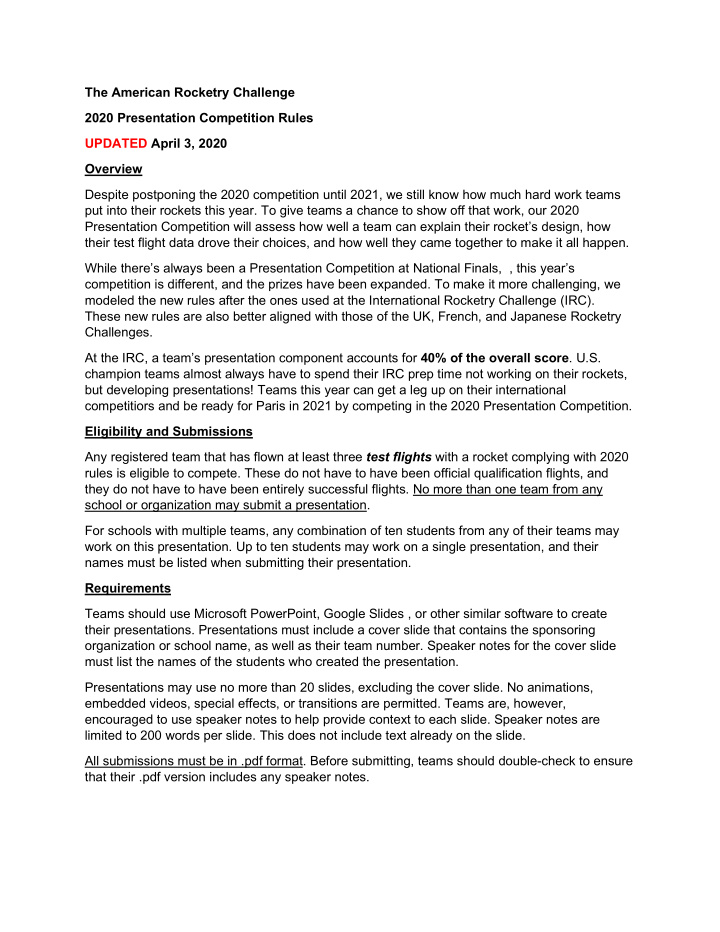



The American Rocketry Challenge 2020 Presentation Competition Rules UPDATED April 3, 2020 Overview Despite postponing the 2020 competition until 2021, we still know how much hard work teams put into their rockets this year. To give teams a chance to show off that work, our 2020 Presentation Competition will assess how well a team can explain their rocket’s design, how their test flight data drove their choices, and how well they came together to make it all happen. While there’s always been a Presentation Competition at National Finals, , this year’s competition is different, and the prizes have been expanded. To make it more challenging, we modeled the new rules after the ones used at the International Rocketry Challenge (IRC). These new rules are also better aligned with those of the UK, French, and Japanese Rocketry Challenges. At the IRC, a team’s presentation component accounts for 40% of the overall score . U.S. champion teams almost always have to spend their IRC prep time not working on their rockets, but developing presentations! Teams this year can get a leg up on their international competitiors and be ready for Paris in 2021 by competing in the 2020 Presentation Competition. Eligibility and Submissions Any registered team that has flown at least three test flights with a rocket complying with 2020 rules is eligible to compete. These do not have to have been official qualification flights, and they do not have to have been entirely successful flights. No more than one team from any school or organization may submit a presentation. For schools with multiple teams, any combination of ten students from any of their teams may work on this presentation. Up to ten students may work on a single presentation, and their names must be listed when submitting their presentation. Requirements Teams should use Microsoft PowerPoint, Google Slides , or other similar software to create their presentations. Presentations must include a cover slide that contains the sponsoring organization or school name, as well as their team number. Speaker notes for the cover slide must list the names of the students who created the presentation. Presentations may use no more than 20 slides, excluding the cover slide. No animations, embedded videos, special effects, or transitions are permitted. Teams are, however, encouraged to use speaker notes to help provide context to each slide. Speaker notes are limited to 200 words per slide. This does not include text already on the slide. All submissions must be in .pdf format. Before submitting, teams should double-check to ensure that their .pdf version includes any speaker notes.
Judging A panel of five NAR judges will review presentations and score them out of 120 total points, based on the following six equally weighted categories: 1. Explain your rocket. How did your team reach this design? What are the dimensions, construction materials, weight, and motor type selected, and how were these decisions decided? 2. Teamwork. Teamwork is critical in the aerospace industry. How did each member of the team contribute to your efforts, such as rocket design, construction, flight testing, or other elements of the team’s operation, including outreach, fundraising, and the writing of this presentation? 3. Rocket science – How did your team do the tradeoffs among rocket drag, weight, and motor selection to try to achieve the altitude performance target in your initial design? How did you select parachute size? How did you account for different weather conditions at the time of launch in your plan to achieve the performance targets? 4. Flight testing – How did your team use flight data collection and analysis to refine your approach to the mission and make the adjustments after flights to try to achieve a better score? How did you intend to make adjustments to the rocket at the Finals, depending on whether the target altitude was 775 feet or 825 feet for your first flight there? Does the presentation document at least three flights (successful or not) with a 2020 rules- compliant rocket? 5. Lessons learned – What lessons did you learn from your experience about how to do a team-based engineering design and construction project, and how would you change your approach for future competitions? 6. Presentation Quality . Were the slides numbered, uncluttered, not excessively wordy, and present information clearly? Did they tell a coherent end-to-end story and cover the five key subjects (above) of the judging? Did they comply with format and content requirements and use grammatical English with proper spelling? Did they use appropriate techniques to display data? Did the speaker notes relate to and clarify the material on the slides without merely repeating it? Teams that are concerned about accurately referencing rocketry fundamentals should go to our Resources page. There, a wealth of videos, articules, and handbooks cover many aspects of rocketry that you’ll need to reference in your presentation if you want to succeed. Prizes The winning entry will be awarded $2,000 along with a commemorative plaque. Second place will received $1,000, and third place, $500. An additional $1,000 has been set aside for a “Best Newcomer” award. Best Newcomer is defined as a team from a school or organization that has not had a team compete in the National Finals in the last ten years, and does not have a student or teacher on the team that has been to a National Finals in the last ten years. All teams that enter will receive custom certificates, and thank-you’s from our sponsors honoring their work in the 2020 Presentation Competition
Submissions To submit your team’s presentation, go to the Presentation Competition page, and click the “Submit Your Entry” button to be directed to the submission form. All entries are due Friday, May 1. The top three teams will be announced no later than Monday, June 1 .
Recommend
More recommend